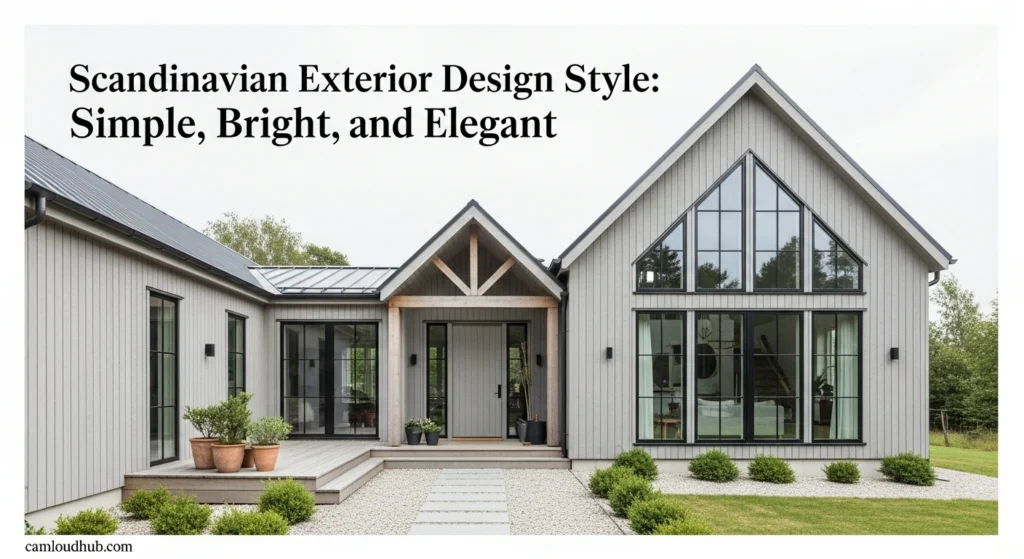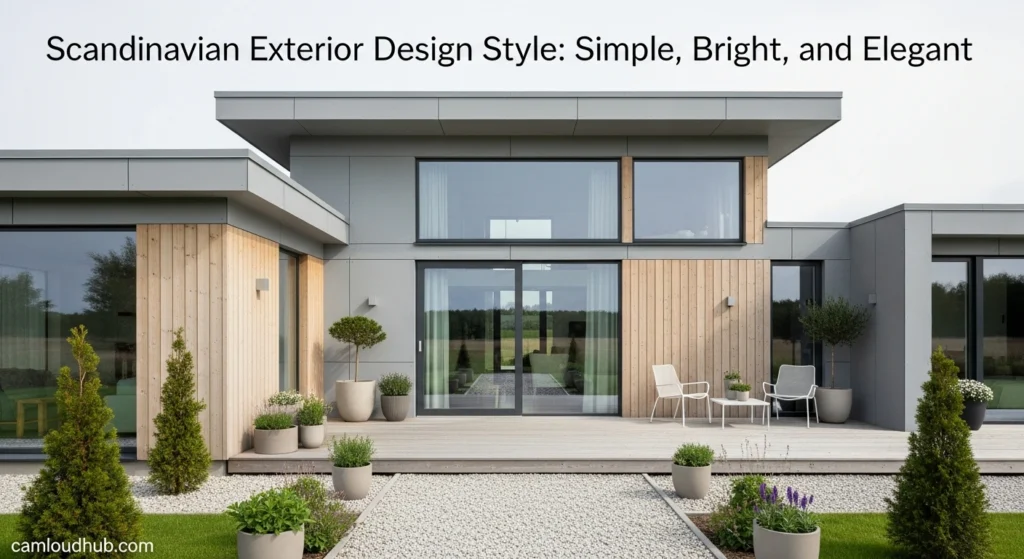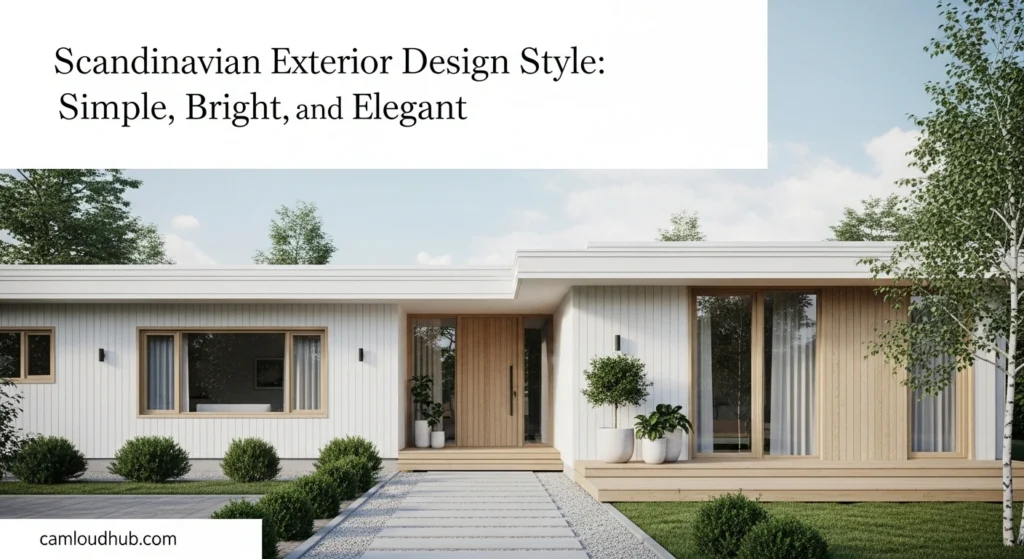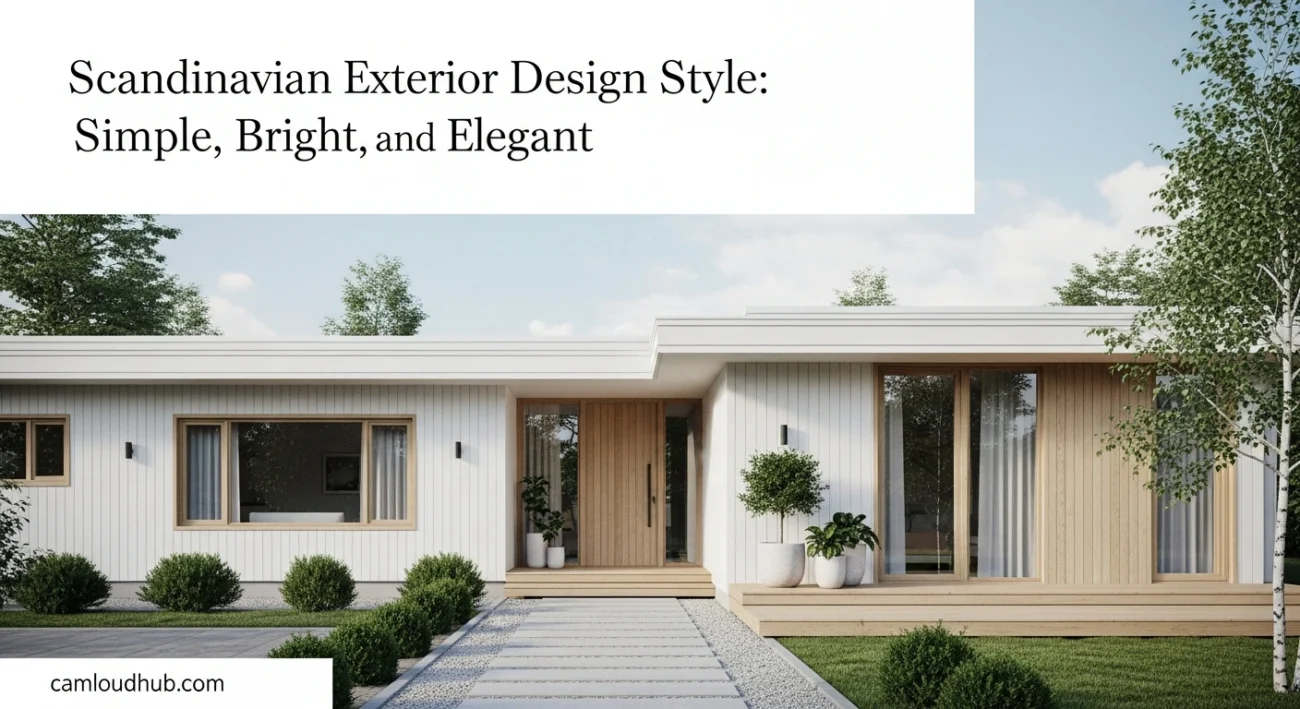The Philosophical Roots of Scandinavian Exterior Design: More Than Just a Look
Scandinavian Exterior Design Style: Simple, Bright, and Elegant – The allure of Scandinavian exterior design stems not merely from its visual appeal, but from a profound design philosophy rooted in Nordic values. It’s a style that prioritizes functionality, connection to nature, and an inherent respect for materials and light. Understanding these underlying principles is key to appreciating and implementing this truly distinctive aesthetic.
The severe beauty of the Scandinavian landscape, with its long, dark winters and brief, bright summers, profoundly shaped this design approach. Homes needed to be resilient, energy-efficient, and capable of maximizing every precious ray of sunlight. This practical necessity evolved into an aesthetic choice, favoring stark contrasts, clean lines, and an enduring connection to the natural world just beyond the threshold.

Simplicity and Utilitarianism: The Core Doctrine
At the heart of Scandinavian exterior design lies an unwavering commitment to simplicity and utilitarianism. Every element, from the overall form of the building to the smallest architectural detail, serves a purpose. There is a deliberate absence of superfluous ornamentation, with the belief that true beauty emerges from clean lines, honest materials, and functional efficiency. This approach results in designs that are both timeless and incredibly robust.
The focus is on delivering practical solutions without compromising on aesthetic quality. This means considering how a home performs in varying climates, how its spaces flow, and how it reduces its environmental footprint. A structure built with Scandinavian exterior design principles in mind is not just visually appealing, but also inherently smart and sustainable. It’s a design language that values longevity and enduring utility over fleeting trends.
Embracing Nature: A Seamless Integration
A hallmark of Scandinavian exterior design is its profound connection to the natural world. This isn’t just about using natural materials; it’s about designing buildings that feel like an organic extension of their environment. The goal is to minimize the boundary between inside and out, creating a cohesive living experience that celebrates and respects the landscape. This philosophy is deeply ingrained in the Nordic way of life, where nature is both a source of inspiration and a vital part of daily existence.
The choice of site, the orientation of the building, and the integration of exterior spaces are all critically considered. Large windows frame views like living art, while outdoor areas are designed to flow effortlessly from the interior. This thoughtful integration ensures that a home built with Scandinavian exterior design principles never feels isolated but rather deeply rooted in its surroundings, offering occupants a constant dialogue with nature.
Maximizing Light: A Beacon Against the Dark
The harsh reality of long, dark winters in Scandinavia forged a powerful imperative: the maximization of natural light. This need translated into a fundamental principle of Scandinavian exterior design, where every effort is made to invite as much daylight as possible into the home. Light is not just functional; it’s an intrinsic element of the design’s serene and uplifting quality, combating gloom and enhancing mood.
This emphasis on light manifests in various architectural choices, from generously sized windows and glass doors to strategic building orientations. Light-colored exteriors also play a crucial role, reflecting and amplifying available light, making homes appear brighter and more open even on overcast days. A well-lit home, in the Scandinavian exterior design paradigm, is not just brighter, but also feels larger, more inviting, and intrinsically healthier.
Key Elements Defining Scandinavian Exterior Design Authenticity
To truly capture the essence of a Scandinavian exterior design, one must understand its definitive architectural and material elements. These components work in harmony to create the signature look—simple, clean, and deeply resonant with the natural world. Each choice, from cladding to roofline, contributes to the overall narrative of functional elegance and understated beauty.
These elements aren’t merely decorative; they are performance-driven choices honed over centuries of adapting to challenging environmental conditions. They reflect a commitment to durability, sustainability, and a deep appreciation for craftsmanship. By focusing on these core elements, one can meticulously craft an exterior that authentically embodies the spirit of Scandinavian exterior design.
Materiality: Honesty and Natural Beauty
The choice of materials is paramount in Scandinavian exterior design, reflecting a deep respect for natural resources and a commitment to longevity. Materials are chosen for their inherent beauty, durability, and ability to age gracefully. There is a profound honesty in their use, often left exposed or treated minimally to highlight their natural textures and character. This raw beauty contributes significantly to the style’s enduring appeal.
- Wood: Undoubtedly the most iconic material, wood is the protagonist of many Scandinavian exterior design projects.
- Types: Pine, spruce, larch, and often fir are favored for their abundance, strength, and aesthetic qualities. They are used for cladding, decking, window frames, and structural elements.
- Treatments: Wood is frequently left untreated or given light stains or paints (historically Falu Red, but often white, black, or grey now) that allow its grain and texture to remain visible. This celebrates the material’s natural state and allows it to weather gracefully over time, developing a beautiful patina. Vertical or horizontal timber cladding creates distinct visual rhythms, adding texture and interest to otherwise simple facades.
- Stone: Used for foundations, retaining walls, or accent features, natural stone provides a grounding, robust counterpoint to lighter woods. Its organic shapes and textures further tie the home to the landscape, enhancing the rustic yet refined feel often associated with Scandinavian exterior design.
- Metal: Standing seam metal roofs (often in dark grey or black) are common, offering exceptional durability and a sleek, contemporary edge. Other metals like zinc or copper might be used for detailing or rainwater systems, chosen for their longevity and the character they develop as they patinate over time.
- Concrete: While less common for primary cladding in traditional designs, polished or raw concrete can be incorporated in modern interpretations of Scandinavian exterior design. It provides a strong, minimalist base, often used for foundations, patios, or architectural accents, juxtaposing beautifully with warmer woods.
- Glass: Large expanses of high-performance glass are integral, blurring the lines between interior and exterior. Window frames are typically thin and often dark, framing views like works of art and maximizing light ingress. This transparent element is crucial for fulfilling the style’s mandate of light maximization.

Color Palettes: Serene and Grounded Hues
The color scheme in Scandinavian exterior design is deliberately restrained, serving to enhance light, highlight natural materials, and blend harmoniously with the landscape. These palettes are carefully curated to evoke a sense of calm, clarity, and understated elegance. Whites, grays, and muted earth tones dominate, often punctuated by strategic dark accents that provide depth and contrast.
- Whites and Off-Whites: These are perhaps the most recognized colors, chosen for their unparalleled ability to reflect light and create a sense of openness. White facades feel fresh, clean, and optimistic, particularly important in climates with limited sunlight. They also provide a crisp backdrop that allows the textures of wood and stone to truly shine.
- Greys: Ranging from light, silvery shades to deep charcoal, greys offer a sophisticated and natural alternative. They harmonize beautifully with both stone and weathered wood, providing a subtle connection to rocky landscapes and overcast skies. Darker greys can add a grounding weight to a home, making it feel solid and understated.
- Muted Naturals: Soft greens, blues, and browns, often in desaturated tones, might appear as subtle accents or in natural materials themselves. These colors draw direct inspiration from the surrounding forests, lakes, and soil, reinforcing the home’s integration with its environment.
- Black Accents: Increasingly popular in contemporary Scandinavian exterior design, black is used sparingly but powerfully. Dark window frames, door surrounds, or a feature wall of black-painted wood cladding can create dramatic contrast and define architectural elements. Black provides a modern edge while retaining the overall sense of minimalist elegance.
- Falu Red: A historical and iconic Swedish color, Falu Red is a deep, earthy red derived from copper mining byproducts. It’s still seen on traditional farmhouses and cottages, offering a warm, inviting, and distinctly Nordic charm. While not as universally adopted as whites or greys, it’s a nod to the style’s rich heritage.
Rooflines and Forms: Clean, Functional, and Unadorned
The architectural forms and rooflines in Scandinavian exterior design are characterized by their simplicity, clean lines, and functional integrity. Elaborate ornamentation is absent; instead, the beauty lies in the precision of the construction and the clarity of the building’s shape. These forms are a direct response to climate and function, yet they achieve a striking aesthetic appeal.
- Simple Gables: The classic pitched roof remains a staple, often seen with a steeper pitch to shed snow efficiently. The gable end is frequently left unadorned, emphasizing the geometric purity of the form. Variations include half-gables or offset gables that add subtle architectural interest without complexity.
- Flat Roofs: In more modern interpretations of Scandinavian exterior design, flat roofs or low-sloped roofs are prevalent. These contribute to a sleek, minimalist silhouette, aligning with contemporary trends towards streamlined aesthetics. They also lend themselves well to green roofs, further connecting the home to nature.
- Shed Roofs: A single-slope roof, often used for extensions or smaller structures, provides a contemporary touch and can be oriented to maximize solar gain or shield from prevailing winds. This functional roof type contributes to the clean, asymmetrical lines favored in some designs.
- Clean Lines and Massing: Regardless of the roof type, the overall massing of a Scandinavian exterior design is typically composed of clear, geometric forms. Rectangular volumes are common, sometimes interlocking or offset to create visual interest. This clarity of form contributes to the style’s tranquil and orderly appearance. Fenestration is regularly spaced and proportioned, reinforcing the architectural rhythm.
- Overhangs: While not overly elaborate, modest roof overhangs are common to provide shelter from rain and sun, a practical element that also adds depth and shadow to the facade. These contribute to the utilitarian aspect of the design, protecting walls and windows.
Creating Your Own Scandinavian Exterior: Practical Applications and Design Considerations
Translating the principles of Scandinavian exterior design into a tangible home requires careful consideration of various practical aspects. From landscaping to lighting, every detail contributes to the overall aesthetic and livability. This section delves into actionable advice for those looking to infuse their property with the simple, bright, and elegant charm of the Nordic style. It’s about blending aesthetic ambition with functional necessity, creating a home that is both beautiful and deeply livable.
The approach is holistic, ensuring that the outdoor spaces complement the architectural style seamlessly. This means thinking about more than just the building itself, but how it interacts with the ground it stands on, the light it receives, and the life that unfolds around it. By following these guidelines, you can thoughtfully extend the serenity and functionality of Scandinavian exterior design to your entire property.
Landscaping for Scandinavian Homes: Minimalist and Integrated
Landscaping in Scandinavian exterior design is approached with the same restraint and respect for nature as the architecture itself. The goal is not to overpower the home with elaborate gardens but to create a harmonious blend that enhances the natural beauty of the site. This translates into minimalist designs that require less maintenance and allow the building to remain the focal point.
- Native and Unfussy Plants: Prioritize native or climate-appropriate plants that thrive in your region without extensive intervention. Think hardy evergreens, simple grasses, ferns, and wildflowers that offer texture and subtle color variations. These plants often mirror the resilience of Nordic flora, requiring minimal fuss and seamlessly integrating with the immediate ecosystem.
- Clean Lines and Defined Areas: Geometric shapes for garden beds, pathways, and seating areas are common, reflecting the architectural precision of the home. Gravel paths, neatly edged mulch beds, or simple stone pavers define spaces without fussiness. This creates an organized yet organic flow, complementing the ordered nature of Scandinavian exterior design.
- Connection to Indoor Spaces: Design outdoor areas to feel like extensions of your home. Patios or decks should be easily accessible from living areas, promoting indoor-outdoor living. Consider incorporating outdoor rugs, simple furniture, and perhaps a fire pit to create an inviting “outdoor room.” This blurs the line between built and natural environments, a core tenet of the style.
- Minimalist Hardscaping: Use paving materials like large format concrete slabs, natural stone, or fine gravel. Avoid overly ornate patterns. Low walls or edging made of natural stone or wood further connect the hardscaping to the natural world. This emphasis on subtle hardscaping ensures that the landscape remains understated and contributes to the serene feeling of the Scandinavian exterior design.
- Water Features (Subtle): If incorporating water, keep it simple—a quiet reflective pond, a small stone fountain, or a naturalistic stream. The sound and sight of water can add a calming element without distracting from the overall minimalist aesthetic. Such features enhance the tranquil atmosphere often sought after in a Scandinavian exterior design.
Entryways and Outdoor Living Spaces: Hygge and Functionality
The entryway is the first impression of a home, and in Scandinavian exterior design, it sets the tone for welcoming simplicity. Outdoor living spaces are equally important, designed as extensions of the indoor comfort, fostering “hygge”—a sense of coziness, contentment, and well-being. These areas are crafted for both functionality and aesthetic pleasure, inviting connection and relaxation.
- Welcoming Simplicity at the Entry:
- Defined Paths: A clear, uncluttered path leading to the front door, made from stone, concrete, or gravel, guides visitors smoothly.
- Minimalist Door: The front door itself is often clean-lined, perhaps in a natural wood finish, a painted accent color (like black or a muted blue), or with simple glass panels. Hardware is understated and functional.
- Subtle Lighting: Wall-mounted sconces or recessed lighting provide gentle illumination without being overly decorative.
- Sparse Decor: A single, well-chosen potted plant, a simple bench, or a small doormat is often sufficient to add warmth and personality, embodying the “less is more” philosophy of Scandinavian exterior design.
- Functional and Cozy Outdoor Living:
- Decking and Patios: Expansive decks or patios crafted from natural wood (e.g., treated pine, cedar, or composite) or large-format pavers create versatile areas for dining and lounging. These surfaces extend the usable living space and are often directly accessible from the interior.
- Outdoor Furniture: Choose sleek, durable outdoor furniture in natural materials like wood, wicker, or metal, with comfortable, simple cushions in muted tones. The emphasis is on comfort and functionality, not excessive ornamentation. Modular pieces offer flexibility.
- Fire Features: A modern fire pit or an outdoor fireplace provides warmth and a focal point, extending the usability of outdoor spaces into cooler evenings. This enhances the “hygge” factor, promoting gathering and relaxation.
- Privacy Screens: Simple slatted wood screens, strategically placed planters, or a low stone wall can offer privacy without fully enclosing the space, maintaining an open feel while providing intimacy. These blend seamlessly with the Scandinavian exterior design aesthetic.
Lighting: Functional and Aesthetic Illumination
Outdoor lighting in Scandinavian exterior design is approached with careful consideration, balancing functional necessity with aesthetic enhancement. It’s about creating an atmosphere that is both safe and inviting, extending the home’s warmth into the evening hours. The goal is to highlight architectural features, illuminate pathways, and create a sense of cozy intimacy without excessive brightness or glare.
- Strategic Placement: Lights are positioned to provide subtle illumination where needed—along paths, near entryways, and to highlight specific architectural details or landscape features. The aim is to create soft pools of light rather than uniform, harsh illumination, enhancing the serene quality of the Scandinavian exterior design.
- Minimalist Fixtures: Choose fixtures with clean lines and simple forms, often in dark metals (black, charcoal) or natural wood. Recessed lighting, discreet path lights, and wall-mounted sconces are preferred over ornate or overly decorative options.
- Warm Color Temperature: Opt for LED lights with a warm color temperature (around 2700-3000K) to create an inviting, natural glow. This mimics the warmth of natural light and contributes to the overall “hygge” feeling, making the outdoor areas feel more comfortable and welcoming.
- Up-lighting and Down-lighting: Use a combination of up-lighting to accentuate building textures or trees, and down-lighting to illuminate pathways or seating areas. This layered approach adds depth and visual interest, making the Scandinavian exterior design truly come alive after sunset.
- Dimmers and Timers: Incorporate smart lighting controls, dimmers, and timers to manage light levels and schedule automatic on/off times. This not only enhances energy efficiency but also allows for flexible atmosphere creation, adapting to different activities and moods.
Sustainable Practices: Building Responsibly
Sustainability is deeply woven into the fabric of Scandinavian exterior design, stemming from a cultural reverence for nature and a practical approach to resource management. Incorporating eco-friendly practices isn’t just a trend; it’s a foundational principle that enhances the home’s long-term value and its relationship with the environment. This reflects a commitment to responsible living and building for future generations.
- Energy Efficiency: Design for optimal thermal performance. This includes robust insulation, high-performance windows and doors (often triple-glazed in colder climates), and a tight building envelope to minimize heat loss or gain. Passive solar design principles, which orient the home to maximize winter sun and minimize summer heat, are also key. This focus on efficiency naturally aligns with the practical aspects of Scandinavian exterior design.
- Local and Recycled Materials: Prioritize building materials that are locally sourced to reduce transportation impact and support local economies. Whenever possible, use recycled or reclaimed materials (e.g., reclaimed wood, recycled metal) to lessen demand on virgin resources. This choice not only benefits the environment but also imbues the home with character and a sense of history.
- Water Management: Implement rainwater harvesting systems for irrigation or non-potable uses. Design landscapes with permeable surfaces to reduce stormwater runoff and encourage natural groundwater replenishment. Drought-tolerant native plants minimize the need for excessive watering, further enhancing the eco-conscious aspect of Scandinavian exterior design.
- Healthy Indoor Air Quality: Select low-VOC (volatile organic compound) paints, finishes, and sealants to ensure good indoor air quality. Natural ventilation strategies, such as cross-ventilation, are also important for maintaining a fresh and healthy living environment—a subtle yet vital extension of sustainable building practices.
- Longevity and Durability: Choose high-quality, durable materials and construction methods that will stand the test of time, reducing the need for frequent repairs or replacements. A truly sustainable home is one that is built to last, minimizing waste and maximizing its lifecycle—a core value inherent in every thoughtfully executed Scandinavian exterior design.
The Enduring Appeal of Scandinavian Exterior Design: Timeless Value and Lifestyle
Beyond its immediate aesthetic appeal, Scandinavian exterior design offers a powerful array of long-term benefits that contribute to its enduring popularity and value. This style isn’t a fleeting trend; it’s an investment in a lifestyle characterized by peace, clarity, and a profound connection to the natural world. Choosing this path means embracing a home that transcends the ordinary, becoming a sanctuary of enduring beauty and functionality.
The value proposition extends far beyond mere curb appeal. It encompasses the psychological benefits of living in a well-ordered, light-filled space, the practical advantages of energy efficiency, and the undeniable draw of a design that remains relevant and cherished across generations. A home expressing Scandinavian exterior design principles stands as a testament to thoughtful, responsible living.
Timelessness and Longevity: An Investment in Style
One of the most compelling aspects of Scandinavian exterior design is its remarkable timelessness. In a world saturated with ephemeral trends, this style offers a refreshing antidote, focusing on purity of form, honest materials, and functional integrity. These fundamental principles ensure that a home built with this aesthetic remains relevant and beautiful for decades, actively resisting obsolescence.
The investment in durable, high-quality materials and meticulous craftsmanship means that homes typically age gracefully, developing character rather than deteriorating. This longevity is not just an aesthetic benefit; it’s a practical and financial one. A well-designed Scandinavian exterior design home retains, and often increases, its value over time, appealing to a broad demographic of discerning homeowners who appreciate lasting quality and understated elegance. It’s a style that transcends fads, offering a truly sustainable approach not just to construction, but to aesthetic permanence.

Promoting Well-being and Calm: A Sanctuary for the Soul
The inherent simplicity, abundant natural light, and seamless integration with nature found in Scandinavian exterior design contribute significantly to the well-being and mental calm of its inhabitants. In an increasingly stressful world, the home becomes a much-needed sanctuary, a place of refuge where clarity and peace prevail. This effect is a deliberate outcome of a design philosophy that prioritizes human experience.
The uncluttered aesthetic reduces visual noise, allowing the mind to relax and focus. Maximizing natural light improves mood, boosts energy, and regulates circadian rhythms, directly combating the effects of modern, often artificial, environments. Furthermore, the constant gentle reminder of nature, visible through large windows and experienced in carefully integrated outdoor spaces, fosters a sense of groundedness and connection to the wider world. Choosing Scandinavian exterior design isn’t just about building a house; it’s about cultivating a healthier, more serene way of life, truly a haven for the soul.
Versatility and Adaptability: Harmonizing with Diverse Settings
Despite its distinct character, Scandinavian exterior design possesses a remarkable versatility and adaptability, allowing it to harmonize beautifully with a wide variety of landscapes and architectural contexts. Whether nestled in a dense forest, overlooking a serene lake, or integrated into a modern suburban setting, the core principles adapt gracefully, enhancing rather than overpowering their surroundings. This flexibility is a testament to the style’s inherent respect for place and its emphasis on clean, universal forms.
The focus on natural materials ensures a fundamental connection to any natural environment, while the clean lines and restrained color palettes provide a sophisticated backdrop that can complement both traditional and more contemporary neighboring structures. It’s a style that speaks a universal language of elegance and simplicity, making it a compelling choice for homeowners seeking a distinctive yet harmonious aesthetic. The inherent adaptability of Scandinavian exterior design means it can be tailored to individual tastes and specific site requirements, always retaining its core identity of functional beauty.
Conclusion
The Scandinavian exterior design style stands as a beacon of clarity and timeless elegance in the architectural world. Defined by its unwavering commitment to simplicity, its profound connection to nature, and an ingenious maximization of light, this aesthetic offers far more than just a beautiful facade. It presents a philosophy of living, a profound appreciation for functionality, and a dedication to creating spaces that foster well-being and tranquility.
Embracing Scandinavian exterior design means choosing a home that is not only visually stunning but also resilient, energy-efficient, and seamlessly integrated with its environment. It’s a style that transcends fleeting trends, offering an enduring appeal and a sense of calm that resonates deeply with the modern homeowner. For those seeking a home that embodies natural beauty, intelligent design, and a serene lifestyle, the answer lies in the simple, bright, and elegant charm of Scandinavian exterior design.


